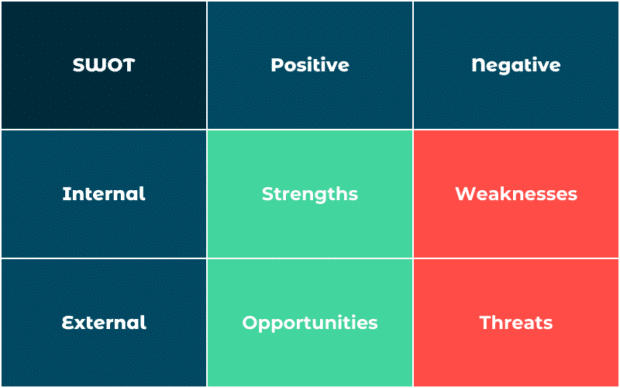A SWOT analysis is a long-proven method of analyzing where your brand stands and how you’re stacking up against the competition. A social media SWOT analysis takes a close look at the social media landscape for your niche. It helps you understand what you’re doing right, where you can improve, and how you can learn from others’ successes and missteps.
Keep reading to find out more about how to run a social media SWOT analysis and the tools that make it a breeze.

Beautiful reports. Clear data. Actionable insights to help you grow faster.
Start free 30-day trialA social media SWOT analysis uses a standard set of categories to analyze your social media performance and look for ways to improve. SWOT stands for:
- Strengths. These are the things you’re already doing right. You’re meeting or exceeding your goals, and you’re at least on pace with the competition.
- Weaknesses. These are areas where your brand could improve, from performance to resources to strategy.
- Opportunities. Opportunities are external factors that present a chance for your brand to excel, like being a successful early adopter of a new platform.
- Threats. These are external factors that could hurt your social performance, like regulation changes or a massive ad spend by a competitor.
Strengths and weaknesses look at internal factors in your social media strategy. Opportunities and threats are focused on external factors.
Conducting a SWOT analysis forces you to think about the big picture. It can be tempting to zone in on your own social media analytics and focus only on strengths and weaknesses. But a SWOT analysis ensures you think about the broader landscape and changes on the horizon, so you can ensure you’re always on top of your game.
Setting annual goals
Since social media changes so fast, it can be useful to conduct a social media SWOT analysis on a regular schedule, like annually or even quarterly.
Having this detailed analysis at your fingertips can help ensure you set challenging but realistic goals and objectives. It can also help you plan ahead for new strategies, surfaces, or features you should have on your radar as you plan your annual budget.
Launching a big campaign
Before you launch a new campaign, it’s important to look back at what has worked well – and not so well – in the past. This applies to both your own campaigns and those of your competitors.
While you don’t want to copy your competitors’ ideas, you can certainly learn from their biggest wins and losses.
Assessing performance
Just as you want to assess the state of affairs before you launch a big campaign, you also want to do so after a campaign has run its course.
In order for this analysis to be a true SWOT, you need to look at more than your own metrics. Your metrics, business goals, and ROI are a good place to start, but remember that a social media SWOT analysis also considers external factors. That means you need to consider opportunities and threats to determine:
- If they impacted the results of your current campaign
- How they might affect the results of a similar campaign in the future
Find your social media strengths
Data in the strengths quadrant of your SWOT analysis should focus on metrics where you’re performing well – especially if you’re performing better than the competition.
Start by gathering your own metrics through social media analytics tools. Then take a look at the competition to see if you can understand where you’re outperforming.
You won’t be able to know all of your competitors’ metrics, of course, but you can certainly access some of them. For example, you can look at public information like follower counts and engagement numbers.
You can also use Hootsuite’s industry benchmarking and competitive analysis features to get an inside look at your competitors’ performance and how you stack up.
Source: Hootsuite Analytics
Looking at your social share of voice and measuring social sentiment are also important ways of understanding and measuring your success.
Identify weaknesses
The process here is pretty much the same as identifying your strengths. Start with your own metrics. Compare your most recent results with results from previous social media campaigns or time periods. Then, benchmark yourself against the competition.
This will allow you to see where you’re falling short, and to identify strategies that worked in the past but are no longer delivering the results you expect.
Get quite specific as you identify your weaknesses. You can’t just say you’re falling behind the competition on TikTok. You probably have some strengths and some weaknesses on every platform, and only by breaking them down in detail can you properly understand what to do next.
For example, maybe your Instagram feed posts are seeing lackluster results, but your Reels are performing better than expected, and you have an active community engaging with your Stories. Or maybe challenge videos are working really well for you on TikTok, but you’re not seeing any traction on brand awareness content.
Once again, you can get some of this information from native social media analytics resources, but a dedicated analytics tool with benchmarking capabilities is useful for more robust analysis.
Beyond your social media analytics, take a look at your organization and list any changes that have the potential to affect your social strategy. Have there been layoffs? Budget cuts? Maybe you’re recovering from a social media crisis?
Monitoring social sentiment can be particularly important here, as it helps you understand the mood behind the mentions of your brand on social media. For example, high engagement numbers on a particular post or platform might initially look like a strength. But if your social sentiment is dropping, you might have uncovered a weakness in disguise.
Source: Hootsuite Insights
A crystal clear picture of your existing strengths and weaknesses will allow you to better understand and benefit from the next sections of the SWOT analysis: opportunities and threats.
Look for opportunities
Remember that opportunities and threats look at factors external to your organization. So, to look for opportunities, you need to make sure you have a firm understanding of what’s happening right now in both the social media world and your own industry niche.
For example, does the new Meta Verified subscription program present a chance for you to stand out from the competition? Conversely, are you missing out on an opportunity if you don’t get verified?
To stay ahead of the curve in your own industry, set up a social listening program using relevant keywords and hashtags to monitor the competition. For example, if conversation volume around a specific keyword is on the rise, there’s opportunity to create content targeting that keyword.
You might also want to keep an eye out for new products, services, or marketing approaches within your niche.
On the social media front, keep an eye on this blog and the Hootsuite social media channels to be the first to know about new developments that might present opportunities for your brand. Our annual Social Media Trends report is a useful read, as are our posts on upcoming social media trends:
You can also identify shifts in the industry through Hootsuite’s social media experiments.
Uncover threats
Just like opportunities, threats are external factors. So, again, you need to understand the climate you’re operating in. It’s especially important to understand any upcoming changes that might threaten your status quo.
For example, the changes to tracking and third-party cookies that started with iOS 14 radically changed the way marketers track and target online ads. But those changes were announced well in advance. The social platforms took steps to mitigate the impact to advertisers, but smart marketers also dedicated extra funds to testing around that time to learn how to adapt to the change.
And all social media managers know the pain of an algorithm change (we’re looking at you, Instagram). That’s an ongoing existential threat for everyone in the industry, and while you can’t let it dominate your day, it needs to be on your radar so you can plan for ways to pivot. (Like focusing on social SEO instead of hashtags.)
Right now, TikTok is the subject of government scrutiny. What that will mean for marketers is as yet unclear, but this certainly falls into the threat category for anyone who’s primarily built their following and interacts with their target audience on this platform.
Bonus: Get a free social media report template to easily and effectively present your social media performance to key stakeholders.
1. Hootsuite
Hootsuite is a particularly useful tool for social media SWOT analysis because it gives you a clear picture of your social results across platforms, all on one screen.
This side-by-side comparison of data shows which social tools are working best for your brand so you can confidently identify your strengths and weaknesses with the required level of detail.
The industry benchmarking tool shows you how your results compare to the average within your industry. And the competitive analysis feature measures your results against up to 20 specific competitors of your choice. These detailed analyses allow you to identify specific opportunities and threats as they emerge.
In addition, Hootsuite Insights is a useful tool for automating your social sentiment analysis so you always have those results on hand when you undertake a SWOT.
2. Meta Business Suite
Source: Meta Business Suite
The native analytics tools housed within Meta Business Suite give you a picture of your social media results on Facebook and Instagram.
This can help you understand which of these platforms is working best for your brand right now. You can also see how your results differ across surfaces within the platforms as you dive into the details of identifying specific strengths and weaknesses.
3. Twitter Analytics
Source: Twitter Analytics
If Twitter makes up a major portion of your social media activities, Twitter Analytics can be a useful tool.
While you’ll only be able to identify strengths and weaknesses specific to Twitter, you might gain useful insights that help shape your competitive strategy on the platform. You’ll also be well equipped to spot Twitter-specific opportunities and threats.
For more details, visit our Twitter analytics guide.
4. TikTok Analytics
Source: TikTok
If TikTok is your platform of choice, you can gather some key insights from the native analytics platform. However, insights only go back 60 days, which means this tool is less useful for a quarterly or annual SWOT analysis.
We’ve got more info in our TikTok analytics guide.
Other native analytics tools
You get the idea: Native analytics tools help you identify strengths and weaknesses for an individual platform.
The challenge is that a cross-platform analysis will give you the juiciest insights, and you can only do that with a third-party tool. (Unless you copy and paste all your numbers from the various platforms into a spreadsheet. In which case, we’ve got a template to help.)
Still, these native tools are a good way to start your first SWOT analysis, and they’re all free to use. For more info, check out the rest of our analytics guides:
Social media SWOT analysis FAQs
What is a SWOT analysis for social media?
A SWOT analysis for social media is a specific way of looking at your performance and the overall climate in your industry and the social media sphere. SWOT stands for strengths, weaknesses, opportunities, and threats.
How do you do a SWOT analysis for a social media account?
In general, it’s more useful to do a SWOT analysis of your overall social media marketing strategy than to examine a single social profile in isolation. This allows you to better understand how to shift resources to maximize your social ROI.
That said, you can perform a SWOT analysis for a social media account by looking at the metrics for that account and comparing them to your own results in the past, then benchmarking your results to those of your key competitors on the same platform.
For the opportunities and threats portion of the analysis, follow updates on the relevant social media platform to make sure you understand any changes that might impact your social marketing efforts going forward.
What are strengths and weaknesses on social media?
Strengths and weaknesses on social media are the social strategies you’re using to the greatest and least effect. Strengths are the things you’re doing really well – in comparison to your own previous results and to the competition.
Weaknesses are areas where you are not doing as well as you have in the past, or you are falling behind the competition. They can also be changes within your company that are affecting performance or that you expect to do so.
A social media SWOT analysis example of strengths might include:
- Reels are consistently getting more engagement than in the previous quarter
- Facebook audience growth exceeds the industry average
- Tagged products on Instagram are resulting in more sales than expected
A social media SWOT analysis example of weaknesses might include:
- Budget cuts are impacting social ad performance
- Facebook Live viewership has declined
Track your social media performance and maximize your budget with Hootsuite. Publish your posts and analyze the results in the same, easy-to-use dashboard. Try it free today.
All your social media analytics in one place. Use Hootsuite to see what’s working and where to improve performance.
Free 30-Day Trial












